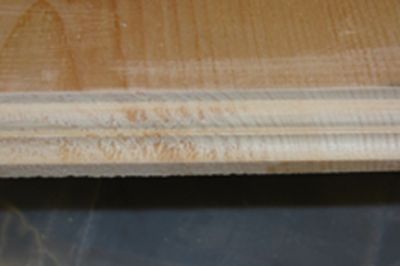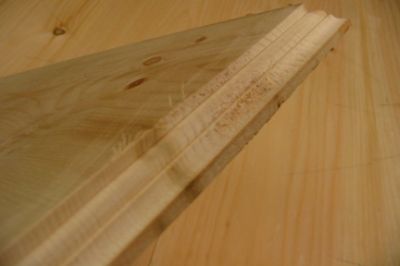Routing and Sanding Pine End Grain
Rough end grain is hard to help with softwood, but here are a few handfuls of advice. January 20, 2007
Question
I make a series of pine boxes that have a layered, profiled lid assembly. I profile the pieces using a 1 1/2 HP PC router in a table with a carbide classic roman ogee bit. I have a speed control on the router and slow it down to profile the end grain, but still have a hard time getting it to look okay, even after a good deal of sanding. Is there a better way to profile pine end grain?
Forum Responses
(Cabinetmaking Forum)
From contributor A:
You don't want to slow down your bit. Router bits are designed to run at very high RPMs. Speed it back up. I am curious as to what you mean by it not looking right. Can you post a picture?
From the original questioner:
Thanks. Here is the issue I'm having. I know routing end grain isn't easy, but I'm hoping to find a better method. Would a larger router help?

One other pic. It's difficult to sand this without ruining the profile

From contributor A:
Oh, you are routing pine. Good luck on that one. The best way to do that is to climb cut it on a shaper. A bigger router, sharper bit won't help - pine is just too soft a wood to machine well. You could try two passes. Take the first pass as usual and climb cut the second pass. You could safely do that by hand. Use a feather board to help prevent it from kicking out and use a very steady and firm grip. You aren't taking that much off, so you should be okay.
Another option might be to nibble away at it feeding into the board. A few light passes should also help prevent that. Wood turners use something to help prevent checking in turning green wood. I don't know off hand what it is or how it works, but that might be an option.
That is the best I have got. I steer clear of pine, not because it is nasty to work with, but because I don't care for it aesthetically. As such, I don't have a whole lot of experience with it. This is a common problem, though, in a lot of woods - just seems to be more pronounced in woods like pine, but the techniques above have always worked for me.
From contributor M:
That is the charm of pine. I don't know that you are going to change that outcome much. You could use HSS bits. They can take a finer edge, but dull faster. With pine, it may be an issue of keeping the pitch off.
Your best bet is to do a search in the Knowledge Base with the topic "profile sanding." You want to maintain your profile while sanding, too. Let me say that you won't get all that tear-out removed. How many of these are you doing and how much money are you willing to throw at the solution?
From the original questioner:
Thanks for the advice. I use about 200 bf a month making the boxes. I use pine mainly as a price advantage, as oak, cherry, birch are 3-4x the price. I get it to finish pretty well, but the profile sanding is driving me nuts. I could throw $3-400 at something if it really saved me time, but I don't think it will be that easy.
From contributor V:
Make sure you have a really good quality bit, not a cheapo, and make sure it's new or sharp. You can make a profile sanding block using bondo and then put sticky sandpaper on it.
From the original questioner:
Thanks. I've been using Katana bits from MLCS and trying to keep them clean of pine pitch. Is there any other better brand of bit you suggest? I'll try the bondo sanding block, too.
From contributor S:
I have to concur on the end grain shaping capabilities in pine (it sucks). Could you switch to poplar? It doesn't have the same degree of tear-out that pine has and is on par price wise.
From the original questioner:
Thanks, but the boxes are stained, so poplar wouldn't work. I do some painted boxes and usually use poplar for those. I may start bread-boarding these lids to reduce the end grain showing.
From contributor V:
I have not used them, but because of the price, I stayed away from them. I usually use CMT, Amanna or Whiteside. All carbide is not the same.
From contributor K:
I agree about climb-cutting... that's going to help a lot. Three cuts - material removal and first profile cut, profile cut #2 to clean it up, and one last profile cut (64th height adjustment) for finishing. One other thing, when doing the final pass on the finishing cut, keep the speed up and move the router at a slower pace. I think you'll be much happier with the results. Also, for anything else left, contributor V is right about the profile sanding.
From contributor L:
Try Whiteside bits, if they've got the profile you need. They're about as good as it gets. They're often more expensive, but worth the money. They hold up better than most of the others. As the others suggested, shape the profile in several passes, and keep the carbide clean. Pine makes a mess because of the resin.
From contributor T:
Poplar will work for staining just fine and will give you better results than pine. Try a dye first, then washcoat, then gel stain followed by a sealer and two more finish coats.
From contributor A:
Since the subject of using poplar has arisen, I'll throw my two cents in. Alder is a much better substitute. Around here, the Midwest, it is the same price as poplar and much nicer. Ash would be another idea, but I am unsure as to the price. Both would be nicer than poplar, though. If all you are using is small pieces, you may be able to find a mill who will sell you drop offs of nicer wood, i.e. maple, for a fraction of their market value. Also, since you don't use a lot, you may be able to hit up other shops in your area and buy up their scraps. They have to pay someone to throw them away, and I am sure they would be willing to sell to you very cheap - I would. I am assuming these are small boxes of course, because you wouldn't get very big drop offs. Hence the term "drop off." At one shop, we had a guy come in about once a month and rummage through the garbage and take what he wanted. Owners didn't mind. He didn't bother anyone and was saving the company money, although not much. He would use the scraps to make these ugly-as-sin cork boards out of old wine corks that he would donate to charities for them to sell at fundraisers. I guess beauty is in the eye of the beholder.
From contributor J:
You could also mount a feeder on your router table. The little 1/4 HP feeders are cheap and work pretty well. Maybe look into an insert style bit for the router. I just recently went to insert for a router chamfer cut and get excellent results - no more sanding touch-up. The carbide is sharper, closer to HSS, but keeps longevity of carbide.
From Professor Gene Wengert, forum technical advisor:
Machining end grain is quite similar to trying to cut the ends off a bundle of straws. Eventually, the knife will cut, but it will likely tear and not create a smooth surface. The sharper the knife (avoid carbide compared to high speed steel), the better the success. Also, if we could stiffen the fibers (or straws), then they will cut better. Stiffening is sometimes done with glue size or a sanding sealer or washcoat. Low MC also stiffens. Shallow cuts, however, will often result in pushing the fibers over rather than cutting them.


